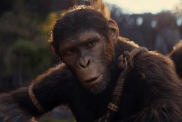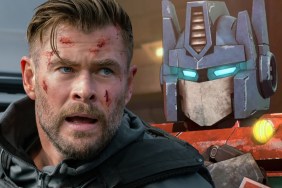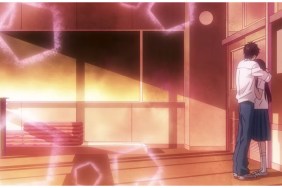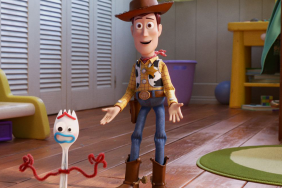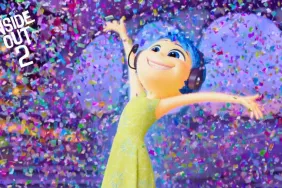
Last week, the first reviews for Pixar Animation’s Inside Out popped up (including our own), following the movie’s premiere at the Cannes Film Festival, but now we want to go back in time to early April when ComingSoon.net had a chance to visit Pixar Animation Studios in Emeryville, California and get to look into the minds of the creative people that made Inside Out a reality.
Hopefully, you’ve already checked out our interview with director Pete Docter and producer Jonas Rivera—and we’ll have more from both of them soon—but we want to get more into the production process behind how the creative folks at Pixar were able to take Pete and Jonas’s initial concept and turn it into a full-fledged feature film.
As you hopefully know by now, Inside Out revolves around an 11-year-old girl named Riley who is dealing with her parents moving her to San Francisco, but it tells the story from inside her mind as five emotions: Joy, Sadness, Anger, Fear and Disgust (voiced by Amy Poehler, Phyllis Smith, Lewis Black, Bill Hader and Mindy Kaling, respectively) wrangle for control. It’s Docter and Rivera’s follow-up to their Oscar-winning animated feature Up, which received four other Oscars including a win for Michael Giacchino’s score.
On our visit, we really didn’t follow the creative path in any sort of order in terms of how production progress–we just went from one conference room to the next, sitting in for each presentation—but we’ll try to make things easier to follow by shifting things around into a chronological order.
Creating the Look With Ralph Eggleston

Production Design is one of the earliest stages of planning once a Pixar filmmaker comes up with an idea and a script is written, because that key department has to help design the world and the characters while the script is still being developed. Production Designer Ralph Eggleston has been involved in Pixar’s art and animation almost from the beginning. He was the Art Director on Toy Story, the Production Designer on Finding Nemo, WALL•E and now Inside Out (after being involved with Docter’s previous two Pixar films), and he also directed the short film For the Birds, which won an Oscar in 2002. Needless to say, he’s another one of Pixar Animation’s staff members who has been at the company so long that he has all sorts of great stories.
The office where Eggleston did his presentation was similarly surrounded by all sorts of early paintings and concept art done by him and his art team to try to visualize the ideas from Docter and his co-screenwriters Meg LeFauve and Josh Cooley, the film’s Head of Story. (We actually would see more of the early concept art, designs and maquettes when we would take the Pixar studio tour later.) He walked us through the artwork showing some of the designs for the Headquarters and the various personality islands that are created inside Riley’s mind. He also showed us early concept for other areas within Riley’s mind like Imagination Land, Dream Productions and the Subconscious where Joy and Sadness end up on their journey. As we’d learn during our visit, the dinner table scene where we get to look inside the minds of Riley’s mother and father was pivotal to them finding the tone behind the concept.
Visualizing the Story with Ronnie Del Carmen

The next step begins shortly after that as the story department starts breaking down the script into storyboards and Docter’s co-director Ronnie Del Carmen talked to us through the process of how Pixar’s artists gather in a room to spitball and draw ideas. A great deal of what they do at Pixar is to “draw the story” rather than write it, and Del Carmen proceeded to talk us through the storyboards for an extended scene of Joy trying to cheer Sadness up because she was being so gloomy. Del Carmen confirmed what Eggleston told us about the dinner scene between Riley and her parents being one of the first ideas that everyone in the room loved. It was a strong enough sequence that it carried through the initial marketing of the film when Disney first showed footage from Inside Out at D23 in 2013.
Later, we had a chance to talk to co-director Ronnie Del Carmen more about his background at Pixar and how he came onto the project as Docter’s co-director… for anyone who may want to get into animation and work at Pixar themselves.
ComingSoon.net: How long have you been at Pixar?
Ronnie Del Carmen: I’ve been at Pixar for 15 years.
CS: It seems like every one I’ve spoken to every time I come here, 15 years is usually the minimum they’ve worked here.
Del Carmen: I know. We were still at Point Richmond when I joined.
CS: Why would anyone leave once they get a job here?
Del Carmen: I know, I’m not thinking about it. I hope they’re not.
CS: What was the first movie you worked on here?
Del Carmen: First movie I worked on here was “Finding Nemo.” I came to Pixar wanting to be hired. They interviewed me. The interview here at Pixar is amazing. Everybody comes out to see you. I met everybody I needed to meet on that one-day interview short of Steve Jobs himself, who I met later on. That day, it felt like a Hollywood musical, and I still have it in my head. I go from Frogtown to Bugville. I met Bob Peterson and Jason Katz and then I met Andrew Stanton and all of these other people. It was a whirlwind. They came around and then we would walk over to the other building. I walked outside and there was Ed Catmull and John (Lasseter) walking from one building to another, and it felt like “Ah, did Busby Berkley somehow orchestrate this to happen?” because I shook hands with everybody! Who were not necessarily there to hire a story artist—they were just moving around. It was like having the cast of Disneyland. “Oh, there’s this person and this person!” I would have been very, very heartbroken if they didn’t hire me.
CS: Jonas was talking about his first days here as an intern and watching the army soldiers scene from “Toy Story” and that was like his first day here.
Del Carmen: I know. I was so happy that they accepted me, but I thought I was being interviewed to work on “Monsters, Inc.” and then when I showed up there were pictures of fishes around. “Wait, what movie am I working on?” “You’re working on ‘Finding Nemo.’” “What? That’s awesome!”
CS: Did you end up working on “Up” with Pete and Jonas?
Del Carmen: I ended up working as the story supervisor on “Up,” so that was an amazing story to tell. We went to Venezuela and climbed Tepuis. A sporty and jock type artist. No, we’re terrible. Climbing a mountain vertical overhand with no ropes.
CS: So you were involved with that one from the very beginning as well?
Del Carmen: Yeah, it was very educating.
CS: At what point did Pete say “Okay, I think I want to get a co-director on this”?
Del Carmen: That was a conversation that happened downstairs, right there in the Atrium. He just casually said, “Yeah, I’m thinking that we should make this movie about this girl’s emotions. We should go and make that and I want you to be co-director.” I was like, “Uh, what did you just say?” He just sprung it on me. He was not making any allusions every now and then that… no, he just said, “If you’d like it, I want you to be co-director on my next movie.” “Of course, yes!” And then also I’m thinking, “Now what?” I wrote in my journal: “The world has changed.” And I couldn’t talk about it for the longest time. All I know is that Pete and I worked together on “Up” and we were very collaborative already then, so working on it, being his co-director, just felt like I was going to extend that to a longer time frame and just a little more involvement.
CS: It’s interesting that you see a lot of people at Pixar start in the story or art department and then eventually get to direct their own short or even their own feature. When you’re co-directing with a known director it’s always a little more vague about what the duties are going to be.
Del Carmen: Oh, yeah. Nobody knows what that job is. Believe me, I asked every person here at Pixar what being a co-director is and they were like, “Got me. The good news it that you can talk to a lot of people who have done co-directing including Andrew (Stanton).” But he said, “Bad news is I don’t know what to say you. I can tell you what I did and I can give you some pointers. I don’t know if that’s going to work for you. But good luck!” That’s really it, because it’s not only collaborative but it’s a creative venture. There’s no hard line on where one begins and the other starts, which is great about that but it’s also kind of difficult to discern where to step in with your dance moves and the other person’s dance moves. The only reason that it’s really great to do this job here at Pixar are the people. If you work with Pete Docter, you’re working with one of the most lovable people in the world. It makes me one of the luckiest co-directors Pixar has ever had… I believe.
CS: The system of making animated movies has changed a lot just as the technology has changed. We were talking to Tony earlier (below), which is the first time Pixar has had a sketch animation artist. It’s interesting how it’s changed.
Del Carmen: Technology has helped to make sure that our appetite is sated but it’s actually made our appetites bigger. We’re able to actually do more with the technology, but that means we can also sample a lot of things and fail at them early so we’ll arrive at the actual solutions sooner. It doesn’t make the job easier, it’s just that you can do them faster.
CS: You’re a story artist but do you have a background in animation as well?
Del Carmen: I have no formal training in animation. I learned on the job through various jobs at animation studios. I can fake animate. I know how to time generally from doing storyboards and TV. I can do sheets and all that, but it’s not refined at all like all our experts in animation. But I know enough about animating that my conversations with animators aren’t that awkward.
CS: They’re very smart and technical people.
Del Carmen: But they’re all storytellers. We connect that way when we talk about behaviors. They’re all actors and writers themselves, so when we talk about what’s important about these characters and their behaviors and their motivations, they get it. We don’t have to talk jargon until we actually have to.
CS: It was interesting to go through the storyboards and seeing that you would draw the story rather than writing out a script. Is there a book that has all those drawings that can tell the story?
Del Carmen: Is there a book like that? No, there isn’t, because that would be a very thick… it would be almost like a set of encyclopedias.
CS: What we saw was about ten minutes of the movie right there.
Del Carmen: Yeah, I know, and we cut out every ten drawings in between that, too, but I would like there to be a book of sequences just to see what it looks like. For most people, they believe that the computer does that. No, they’re drawn by hand by people imagining in their heads and scribbling lines on white background, but that would be fascinating to see. We don’t have anything like that.
CS: You talked about that earlier where it doesn’t seem like you just have a screenplay you can hand to all the animators.
Del Carmen: The screenplay in itself is just a bunch of ideas, whether they’re drawn or typed. That’s just how we do it.
And now, back to our tour of the creative process of Inside Out, which takes us into the technical aspects and where the computers come in.
Laying Things Out

What’s interesting about the way Pixar does animation is that a film like Inside Out would actually have not one, but two Directors of Photography. Patrick Lin, the first person we met with, is the film’s Director of Photography for layout, while Kim White is the Director of Photography for lighting. Between the two of them and their respective teams, they handle the jobs of what a single DoP (of cinematographer, if you like) might do on a live-action film. Deciding where the cameras are placed in any particular scene and how the scenes are lit is two separate jobs when it comes to animation.
What may be surprising is that those jobs are done at different times during the production process with Lin working very early on with the storyboard artists and then Reisch coming on after the initial animation is done. Let’s explain.
While lots and lots of people love animated movies, particularly those from Pixar Animation, not many animation fans realize that computer animation is done a little differently than drawn or painted animation. One of the ways where Inside Out differs from other movies is that a good portion of it happens in the “Headquarters” and because there is that one central location, the production design team could literally create a 3-dimensional set on which the scenes between the five emotions could play out. Because there was something resembling a physical set, that meant that Lin’s team could figure out exactly where the characters and cameras would be placed for any given scene as well, and they actually would figure this out before any scenes would go to the animators.
In the case of Headquarters, where Riley’s emotions do all their work, that’s created as a virtual set where Lin can then position the characters and cameras for each scene. Once things are laid out, the scenes are divvied up between the animators.
Bringing Inside Out to Life with the Animators

This was my second visit to Pixar Animation and for some reason the presentation by the animators is always the most fun, maybe because it really gets into the nitty gritty of how Pixar does things differently from other animation houses. On hand to talk to us about this step of the process was Supervising Animators Shawn Krause & Victor Navone, Directing Animator Jamie Roe and Story Artist Tony Fucile. Tony’s job is to maintain some sort of consistency between the various animators and help to translate what Docter wants to them. It’s probably the most fun job of the process, because during animation meetings with Docter, producer Jonas Rivera and others, he literally gets to draw over the animation with the changes that need to be made in the next pass using a fairly new program to enhance the collaborative process. Tony illustrated this by showing us a scene where Joy is trying to get Sadness out of her hair because her mopey demeanor is starting to bring Riley down, so she convinces her to read through some manuals. They mentioned that Docter deliberately worked with less animators than the usual Pixar production.
Lighting the World with Angelique Reisch

Eventually we got to Angelique Reisch, the film’s “Character Lighting Lead,” who is often one of the last people in the production chain once the actual animation is finished, as the characters and backgrounds now need to be lit properly, often times going back to the original concept art for reference. The idea is to recreate the lighting from Eggleston’s original artwork in order to create the mood and shadows that will help give the animated emotions more depth (both literally and figuratively). Like with the layout department and their cameras, Kim White and her team can physically place and move virtual lights in the 3D environment to create the desired effect.
One of the main challenges that separates Inside Out from previous Pixar Animation movies is that the main character, Joy, is an actual light source who is always emanating light, so the question is “How do you light a lightbulb?” That was what Reisch and her team had to figure out for the central character voiced by Amy Poehler. This was probably the most complex portion of our visit, because it was very technical as Reisch explained how they tried to make the light emanating from Joy reflect on the other emotions.
After the presentations, we got to go on the Pixar tour where we could learn more about the history of Pixar and the buildings and how things like the Atrium were designed in a way to make it easier for members of the staff to spend more face-time together. The tour also included a number of rotating art exhibits showing off some of the gorgeous artwork from the talented staff that makes their beloved films.
Inside Out opens nationwide on Friday, June 19, presumably with previews on Thursday night. If you live in other countries, it will open internationally in most of them on the 18th as well.
Inside Out
-
Inside Out

-
Inside Out

-
Inside Out

-
Inside Out

-
Inside Out

-
Inside Out

-
Inside Out

-
Inside Out

-
Inside Out

-
Inside Out

-
Inside Out

-
Inside Out

-
Inside Out

-
Inside Out

-
Inside Out

-
Inside Out

-
Inside Out

-
Inside Out

-
Inside Out

-
Inside Out

-
Inside Out

-
Inside Out

-
Inside Out

-
Inside Out

-
Inside Out

-
Inside Out

-
Inside Out

-
Inside Out

-
Inside Out

-
Inside Out

-
Inside Out

-
Inside Out

-
Inside Out

-
Inside Out

-
Inside Out

-
Inside Out

-
Inside Out

-
Inside Out

-
Inside Out

-
Inside Out


